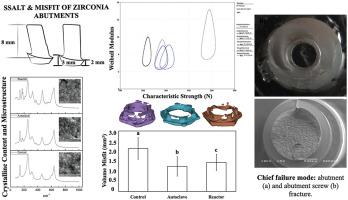Journal of the Mechanical Behavior of Biomedical Materials ( IF 3.9 ) Pub Date : 2021-09-08 , DOI: 10.1016/j.jmbbm.2021.104832 Edmara T P Bergamo 1 , Tiago M B Campos 1 , Adolfo C O Lopes 1 , Karina B Cardoso 1 , Marcus V R Gouvea 1 , Everardo N S de Araújo-Júnior 1 , Lukasz Witek 2 , Petra C Gierthmühlen 3 , Paulo G Coelho 4 , Ernesto B Benalcázar Jalkh 5 , Abbas Zahoui 1 , Laura F de Carvalho 1 , Estevam A Bonfante 1

|
Objective
Evaluate the effect of aging using two different methods on the three-dimensional fit of zirconia abutments at the implant-abutment connection and estimate the probability of survival of anterior crowns supported by straight and 17-degree angled abutments.
Materials and methods
Two different zirconia abutment designs, straight and 17-degree angled abutments (n = 63/group), were evaluated in the current study. The abutments were randomly allocated into three experimental groups according to laboratory aging condition (134°C, 2.2 bar, 20 h): (i) control, (ii) autoclave aging, and (iii) hydrothermal reactor aging. Crystalline content was determined by X-Ray diffraction (XRD) and Raman spectroscopy, and microstructure was analyzed using field-emission gun scanning electron microscope (FEG-SEM). Implant-abutment volume misfit was determined in the straight abutments by micro-computed tomography using the silicone replica technique. For fatigue testing, abutments were torqued to the implants and connected to standardized maxillary incisor zirconia crowns. The assemblies were subjected to step-stress accelerated life testing (SSALT) in water until fracture or suspension. The use level probability Weibull curves and probability of survival for a mission of 50,000 cycles at 50, 100, 150 and 200 N were calculated and plotted. Fractured samples were analyzed using a stereomicroscope and scanning electron microscope.
Results
The crystalline spectra depicted a zirconia system primarily composed of the tetragonal phase. Laboratory aging yielded a 20%- and 37%-increase in the monoclinic content for abutments aged in autoclave and hydrothermal reactor relative to control, respectively. A fully crystalline matrix with a regular grain size was observed in the FEG-SEM for control abutments, with a considerable presence of intergranular defects. While autoclave aging triggered no significant alteration to the microstructure, defect population was reduced after hydrothermal reactor aging. Control abutments presented a significantly higher volume misfit (2.128 ± 0.54 mm3) relative to aged abutments using autoclave (1.244 ± 0.48 mm3) or hydrothermal reactor (1.441 ± 0.41 mm3). The beta (β) values indicated that failures were predominantly controlled by material strength rather than fatigue damage accumulation for all groups, except for straight control abutments. Irrespective of aging, the probability of survival of straight and angled zirconia abutments was up to 95% (95–100%) at 50 and 100 N. A 50N-increase in the load resulted in wider range of survival estimate, with straight autoclave abutments percentage significantly lower probability of survival (77%) than angled hydrothermal reactor abutments (99%). At 200N, angled hydrothermal reactor (97%) or autoclave (82%) aged abutments demonstrated the highest probability of survival, angled control (71%) and straight hydrothermal reactor (69%) abutments intermediate values, and straight autoclave (23%) and control (7%) abutments the lowest estimate. The failure mode predominantly involved abutment and/or abutment screw fracture for both straight and angled abutments.
Conclusions
Hydrothermal aging significantly influenced volume misfit, as well as the probability of survival of zirconia abutments at higher loads for both angled and straight abutments.
中文翻译:

水热老化影响氧化锆基台的三维配合和疲劳寿命
客观的
使用两种不同的方法评估老化对种植体-基台连接处氧化锆基台 3D 拟合的影响,并估计由直基台和 17 度角基台支撑的前牙冠的存活概率。
材料和方法
本研究评估了两种不同的氧化锆基台设计,直基台和 17 度角基台(n = 63/组)。根据实验室老化条件(134°C,2.2 bar,20 小时)将基台随机分配到三个实验组:(i)对照,(ii)高压釜老化,和(iii)水热反应器老化。通过 X 射线衍射 (XRD) 和拉曼光谱测定结晶含量,并使用场发射枪扫描电子显微镜 (FEG-SEM) 分析微观结构。使用硅胶复制技术,通过微型计算机断层扫描确定直基台中的种植体-基台体积不匹配。对于疲劳测试,将基台扭转到种植体并连接到标准化的上切牙氧化锆牙冠。组件在水中进行阶跃应力加速寿命测试 (SSALT),直到断裂或悬挂。计算并绘制了在 50、100、150 和 200 N 下 50,000 次循环任务的使用水平概率 Weibull 曲线和生存概率。使用立体显微镜和扫描电子显微镜分析断裂的样品。
结果
结晶光谱描绘了主要由四方相组成的氧化锆体系。与对照相比,在高压釜和水热反应器中老化的基台的单斜晶含量分别增加了 20% 和 37%。在 FEG-SEM 中观察到用于控制基台的具有规则晶粒尺寸的完全结晶基质,具有相当大的晶间缺陷存在。虽然高压釜老化不会对微观结构造成显着改变,但在水热反应器老化后缺陷数量减少了。与使用高压釜 (1.244 ± 0.48 mm 3 ) 或水热反应器 (1.441 ± 0.41 mm 3 ) 的老化基台相比,对照基台的体积失配 (2.128 ± 0.54 mm 3 ) 明显更高)。β (β) 值表明,除直控制基台外,所有组的失效主要受材料强度而非疲劳损伤累积控制。无论老化程度如何,在 50 和 100 N 下,直型和成角度的氧化锆基台的存活概率高达 95% (95–100%)。负载增加 50N 会导致更大范围的存活估计,使用直型高压灭菌基台存活概率 (77%) 明显低于成角度的热液反应堆桥台 (99%)。在 200N 下,成角度的水热反应器 (97%) 或高压釜 (82%) 老化的基台显示出最高的存活概率,成角度的控制 (71%) 和直的水热反应器 (69%) 基台处于中间值,而直的高压釜 (23%)和控制(7%)基台最低估计。
结论
水热老化显着影响体积失配,以及在较高载荷下,成角度和直的基台的氧化锆基台的存活概率。



























 京公网安备 11010802027423号
京公网安备 11010802027423号